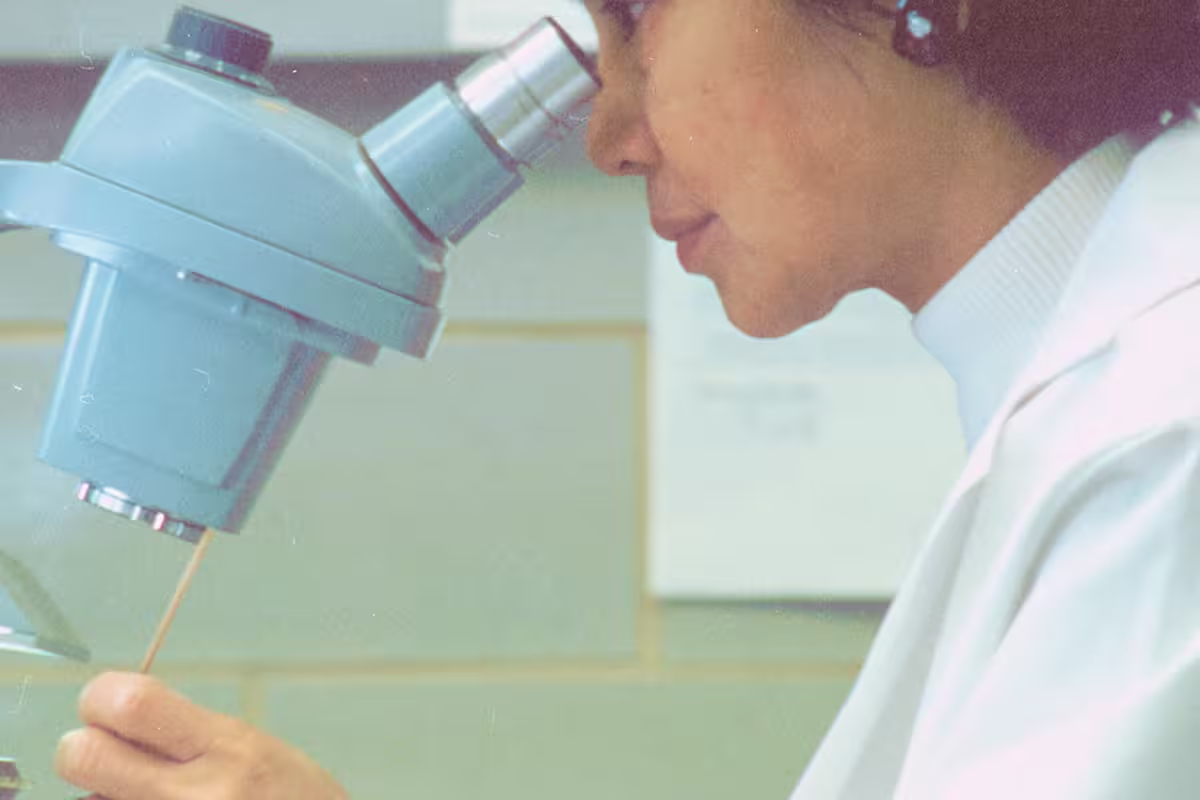

What Is a Vaginal Culture Test?
Learn what a vaginal culture test is, how it detects infections like BV or yeast, and how Evvy’s Vaginal Health Test goes beyond traditional testing.
Words by Olivia Cassano
Scientifically edited by Dr. Krystal Thomas-White, PhD
Medically reviewed by Dr. Kate McLean MD, MPH, FACOG
When something feels off down there, it can be confusing, frustrating, and often worrying. Whether it’s itching, burning, or unusual vaginal discharge, you want answers. That’s where tests like a vaginal culture test come in.
A vaginal culture test is a diagnostic tool that identifies infections by analyzing vaginal discharge for harmful microorganisms like bacteria, yeast, and parasites.
If you’ve ever wondered what a vaginal culture test actually does, how it’s performed, or how it compares to newer options like Evvy’s Vaginal Health Test or vaginal ph test, keep reading.
What is a vaginal culture test?
A vaginal culture test is a diagnostic test used to identify genital tract infections by analyzing a sample of vaginal fluid for harmful microorganisms, such as bacteria, yeast, or parasites. Unlike a vaginal pH test, which can only tell you if your vagina has a normal pH or not, a vaginal culture test is designed to figure out what’s actually going on in your vaginal flora when things don’t feel quite right.
It’s a quick, minimally invasive test that helps pinpoint the cause of symptoms like abnormal vaginal discharge, itching, burning, or discomfort — especially when those symptoms don’t clear up after standard treatments.
What is a vaginal culture test used for?
Your vaginal microbiome — the complex community of bacteria and fungi that naturally live in your vagina — usually keeps itself balanced and healthy. However, certain microbes can sometimes overgrow, leading to irritation or infection. A vaginal culture test helps your healthcare provider find out which microorganism is behind those symptoms.
A vaginal culture test is primarily used to:
- Detect common vaginal infections: This includes bacterial vaginosis (BV), which is caused by an imbalance in vaginal bacteria, yeast infections (vaginal candidiasis), and sexually transmitted infections (STIs) such as chlamydia, gonorrhea, and trichomoniasis.
- Support targeted treatment: If the culture identifies bacteria, the lab may perform a susceptibility test — a follow-up test that determines which antibiotics are most effective against the specific strain found. This ensures you get treatment that actually works, especially if you’ve dealt with resistant or recurring infections.
- Investigate persistent or recurrent symptoms: If your discomfort comes back despite treatment, a vaginal culture test can help your provider pinpoint what’s been missed and tailor a more effective plan.

Recurrent symptoms? Get Evvy's at-home vaginal microbiome test, designed by leading OB-GYNs.
How is the vaginal culture test performed?
The test itself is straightforward and generally quick:
- Sample collection: During a vaginal examination, your healthcare provider uses a sterile cotton swab to collect a small sample of vaginal discharge.
- Lab analysis: The swab is sent to a lab, where the sample is placed in a culture medium — basically a nutrient-rich environment that allows any bacteria, yeast, or parasites present to grow.
- Microbial identification: The lab observes the sample over a few days and looks at which microorganisms are present.
- Susceptibility testing (if needed): If bacterial growth is detected, the lab may test the bacteria’s sensitivity to different antibiotics to determine which medications will be most effective.
- Results: It usually takes three to five days to receive your results, depending on your provider.
How to prepare for a vaginal culture test & next steps
To get the most accurate results, you’ll want to avoid anything that could interfere with the sample’s microbial balance. Here are a few simple guidelines:
- Avoid using vaginal creams, lubes, douches, or medications for at least 48 hours before the test.
- Refrain from having sex for one to two days before testing.
- Let your provider know if you’re on antibiotics or antifungal medication, since these can influence test results.
Once your test is complete, the next step is turning your results into a clear action plan.
If your vaginal culture test identifies a specific infection, your healthcare provider will likely prescribe targeted treatment based on the results. For a bacterial infection, that might mean antibiotics; for yeast infections, antifungal medication.
Your provider may also recommend follow-up testing a few weeks later to confirm that the infection has cleared and that your vaginal microbiome is returning to balance. It’s important to complete the full course of any prescribed medication, even if symptoms improve early, and to attend all follow-up appointments to avoid recurrence or complications.
What the results can (and can't) tell you
When your vaginal culture test results come back, they can reveal quite a bit about what’s happening in your vaginal microbiome, but it’s important to understand both what those findings mean and their limitations.
If a yeast organism such as Candida albicans shows up in your culture, it typically points toward a yeast infection. If the lab identifies certain bacteria linked to bacterial vaginosis — such as anaerobic bacteria like Gardnerella vaginalis or Atopobium— that suggests bacterial vaginosis, where levels of good bacteria have decreased. On the other hand, if your results show no pathogenic growth and a healthy dominance of Lactobacillus, that’s often considered a “normal” result, indicating your vaginal microbiome is in good shape.
However, it’s important to keep in mind that a vaginal culture test doesn’t always tell the whole story. Traditional culture methods depend on the ability of microorganisms to grow in lab conditions, which means some species (especially those that are slow-growing, present in small amounts, or require special conditions) might not show up in the results. A “normal” culture result doesn’t necessarily mean that everything is perfectly balanced; it simply reflects what could be detected using the specific culture technique. The type of lab technology used and how the sample is processed can also influence what’s found.
Also, keep in mind that your vaginal microbiome isn’t static. It can change based on hormones, your period, sexual activity, stress, meds, or even your hygiene routine. What you see today might look different in a week or a month. So, it’s better to think of your test results as part of a bigger picture rather than a solid diagnosis.
It’s also worth noting that the presence of a particular microbe doesn’t automatically mean you have an active infection or that you need immediate treatment. Many microorganisms can live in the genital tract without causing any symptoms or harm. Your healthcare provider will look at your symptoms, medical history, and other factors before deciding what to do next.
And if there’s a chance you could have a sexually transmitted infection, a regular vaginal culture might not cut it. It can find pathogens like Neisseria gonorrhea and Trichomonas vaginalis, but you might need more specific tests to detect STIs like chlamydia, syphilis, herpes, or HIV.
Ultimately, the results of a vaginal culture test are most valuable when interpreted in partnership with your healthcare provider. Together, you can make sense of what the findings mean for your health, determine whether treatment is necessary, and decide on any next steps — whether that’s medication, lifestyle changes, or follow-up testing to ensure your vaginal ecosystem returns to balance.
When should you get tested?
You might consider testing if you’re experiencing:
- Unusual vaginal discharge, a fishy odor, itching, or irritation
- Recurring bacterial vaginosis or yeast infections that resist standard treatment
- Concerns about antibiotic resistance or inappropriate antibiotic use
- Fertility challenges or preparation for pregnancy
- Hormonal changes related to perimenopause or menopause that affect vaginal comfort
- A general desire to understand and maintain your vaginal health proactively.
For acute, severe symptoms, your provider may recommend a culture test first. But if you’ve been dealing with recurring or unexplained issues — or you want to understand your vaginal microbiome as a whole better — Evvy’s test offers more detailed, personalized results.
How Evvy’s Vaginal Health Test works
Traditional culture tests are great for identifying which infection you currently have, but they don’t always provide the full picture of your vaginal health or why those infections might keep returning. They also can’t easily detect microbes that don’t grow well in lab cultures or appear in low numbers.
This is where Evvy’s Vaginal Health Test offers a more comprehensive picture. Rather than relying on what can grow in a petri dish, Evvy uses metagenomic sequencing, an advanced technology that analyzes the DNA of all microorganisms present in your sample. That includes bacteria and fungi, both good and bad, whether or not they can be cultured.
Evvy’s at-home Vaginal Health Test is designed to give you a complete, actionable snapshot of your vaginal microbiome. Here's how it works:
- At-home collection: Get a test delivered straight to you in discreet packaging. After collecting your sample, send it back to Evvy’s CLIA, CLEP, and CAP-certified partner lab.
- Metagenomic sequencing: Instead of growing microbes in a dish, Evvy sequences the DNA in your sample to identify over 700 types of bacteria and fungi, which is far more than a traditional culture test can detect.
- Clinical interpretation: A licensed clinician reviews your results, and Evvy provides a detailed, personalized report explaining what’s happening in your microbiome, why certain symptoms may be occurring, and what steps can support balance.
- Personalized guidance: You’ll also get a free 1:1 session with a certified health coach to help you interpret results and opt in to clinical care and prescription treatment if eligible.
- Progress tracking: You can retest periodically to see how your vaginal microbiome responds to treatments, lifestyle changes, or hormonal shifts.
The entire process happens from home (no speculum or waiting rooms) while still giving you clinically backed insights.
Next steps with Evvy
If you’ve taken Evvy’s Vaginal Health Test, your next steps look a little different (a lot more personalized). Instead of simply identifying an infection, Evvy provides a deeper understanding of your entire vaginal ecosystem, including which microbes are thriving, which may be causing imbalance, and how those shifts relate to your symptoms.
Here’s how Evvy’s aftercare supports you after your results arrive:
- Personalized health report: Your detailed report breaks down every microbe detected (protective, neutral, and disruptive) along with insights about what they mean for your vaginal and overall health, including your fertility.
- Clinician-reviewed results: Every Evvy test is reviewed by a licensed clinician who helps interpret your results within a clinical context.
- Customized next steps: Based on your unique microbiome profile, you’ll receive science-backed recommendations on how to restore balance. This may include lifestyle adjustments, supplements, probiotics, or specific ingredients to look for (or avoid) in treatments.
- Access to prescription treatment: If your results indicate a vaginal infection and you’re eligible, Evvy offers the option to order a personalized prescription treatment program developed by a provider. This ensures that you get fast, targeted care without the hassle of additional appointments.
- 1:1 health coaching: You also have the option to book a free session with one of Evvy’s certified health coaches, who can walk you through your report, help you understand your treatment plan, and answer any lingering questions.
- Ongoing tracking: Because your vaginal microbiome evolves, Evvy makes it easy to retest so you can see how your ecosystem responds to treatment, hormonal changes, or lifestyle shifts.
FAQ
What does a culture test show?
A vaginal culture test shows which microorganisms — such as bacteria, yeast, or parasites — are present in the vagina and may be causing infection. It helps identify conditions like bacterial vaginosis, yeast infections, or trichomoniasis by growing these organisms in a lab so they can be observed and analyzed. In some cases, the lab may also perform an antibiogram to determine which medications will work best against the detected bacteria. However, traditional culture tests can miss microbes that don’t grow easily in lab conditions. That’s why Evvy’s Vaginal Health Test goes further; it uses advanced metagenomic sequencing to detect over 700 bacteria and fungi, offering a more complete picture of your entire vaginal microbiome, including both protective and disruptive species.
What happens if my test is positive?
If your vaginal culture test is positive, it means the lab identified microorganisms that may be causing infection, such as bacteria linked to bacterial vaginosis, yeast-like Candida, or parasites like Trichomonas vaginalis. Your healthcare provider will review the results and likely prescribe targeted treatment, such as antibiotics or antifungal medication, based on what was found. You may also need follow-up testing to confirm that the infection has cleared. If you used Evvy’s Vaginal Health Test, you’ll receive personalized insights and, if eligible, the option to get prescription treatment directly through a provider for faster, tailored care.





